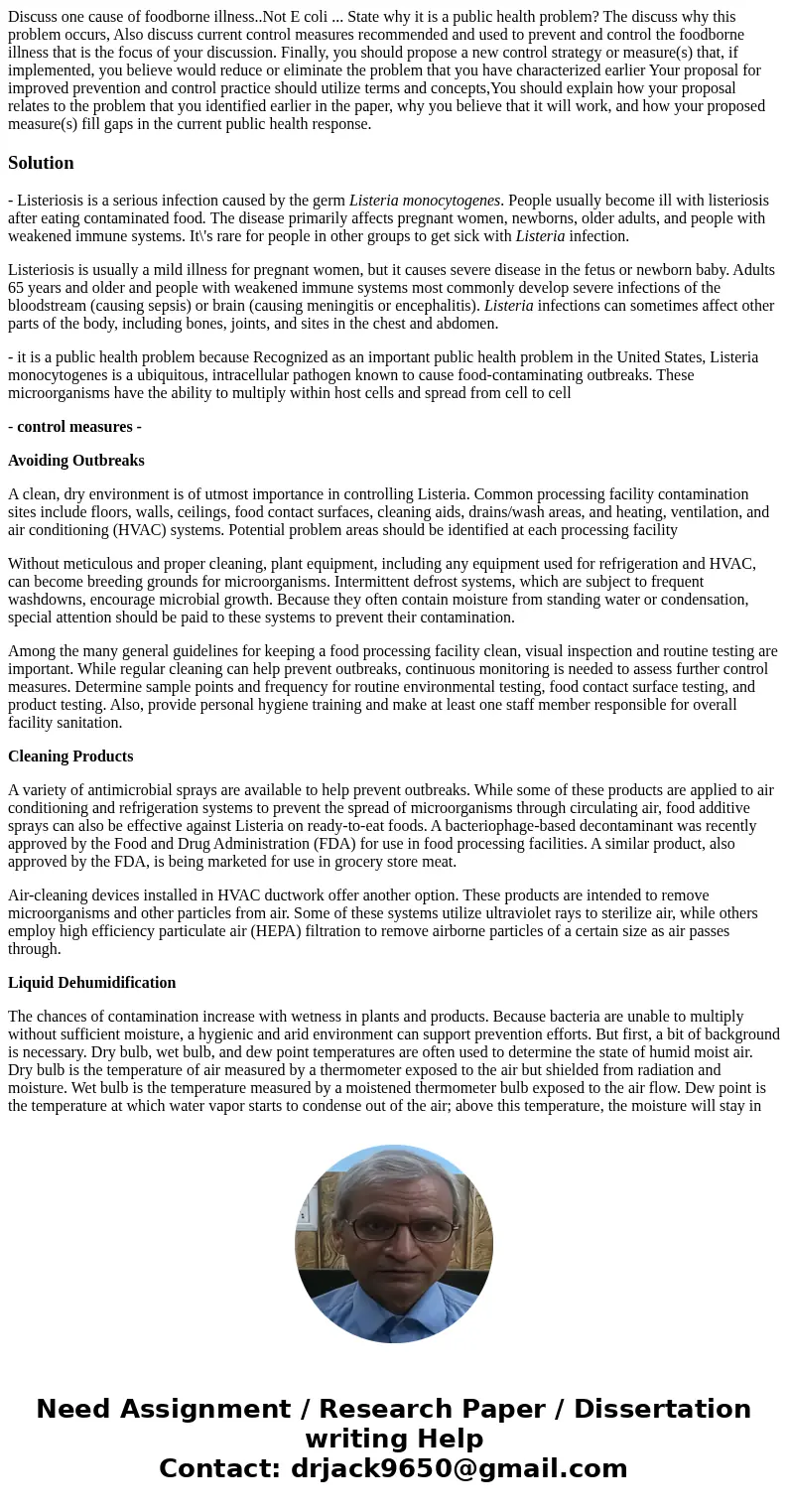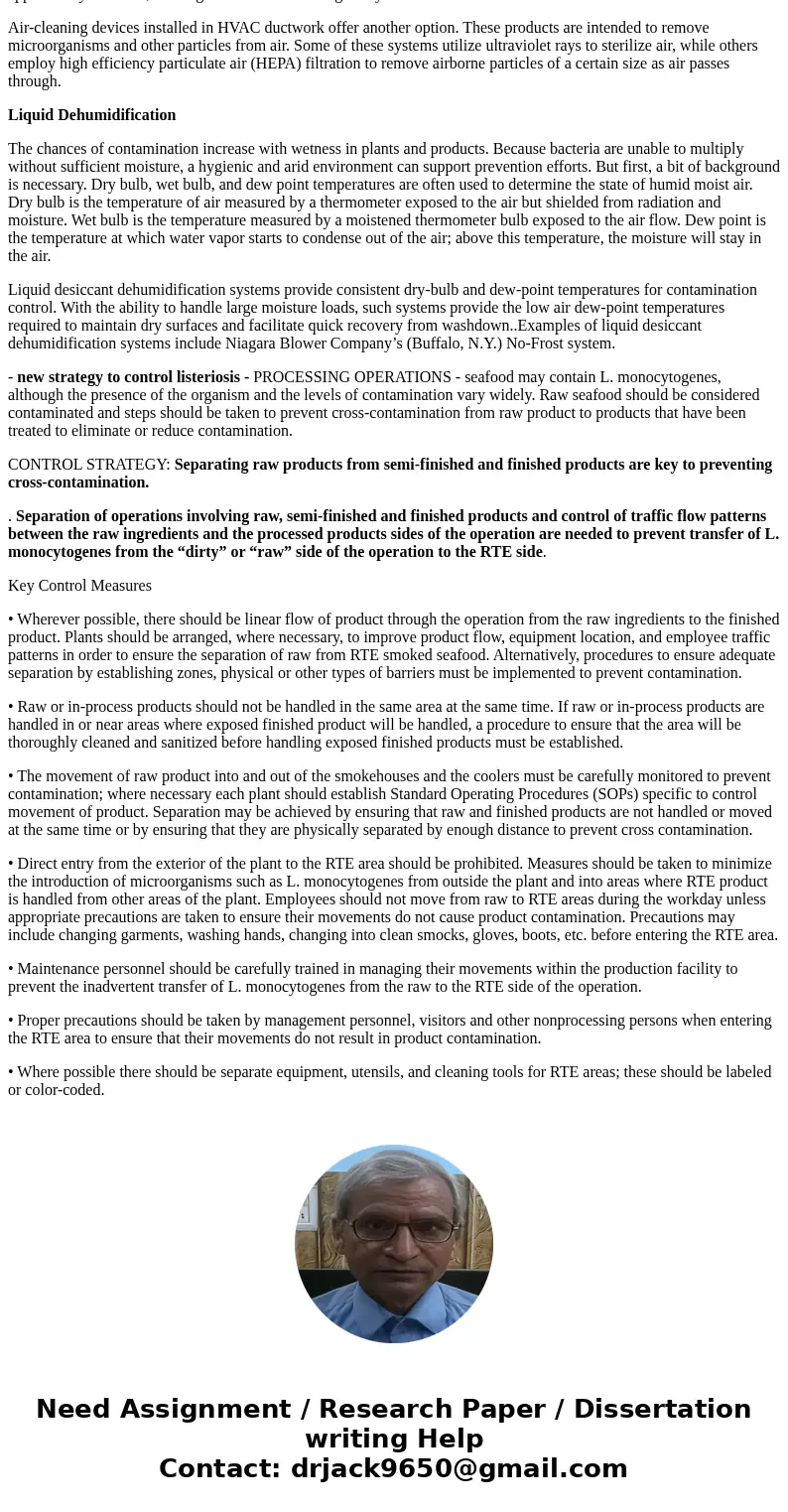Discuss one cause of foodborne illnessNot E coli State why
Discuss one cause of foodborne illness..Not E coli ... State why it is a public health problem? The discuss why this problem occurs, Also discuss current control measures recommended and used to prevent and control the foodborne illness that is the focus of your discussion. Finally, you should propose a new control strategy or measure(s) that, if implemented, you believe would reduce or eliminate the problem that you have characterized earlier Your proposal for improved prevention and control practice should utilize terms and concepts,You should explain how your proposal relates to the problem that you identified earlier in the paper, why you believe that it will work, and how your proposed measure(s) fill gaps in the current public health response.
Solution
- Listeriosis is a serious infection caused by the germ Listeria monocytogenes. People usually become ill with listeriosis after eating contaminated food. The disease primarily affects pregnant women, newborns, older adults, and people with weakened immune systems. It\'s rare for people in other groups to get sick with Listeria infection.
Listeriosis is usually a mild illness for pregnant women, but it causes severe disease in the fetus or newborn baby. Adults 65 years and older and people with weakened immune systems most commonly develop severe infections of the bloodstream (causing sepsis) or brain (causing meningitis or encephalitis). Listeria infections can sometimes affect other parts of the body, including bones, joints, and sites in the chest and abdomen.
- it is a public health problem because Recognized as an important public health problem in the United States, Listeria monocytogenes is a ubiquitous, intracellular pathogen known to cause food-contaminating outbreaks. These microorganisms have the ability to multiply within host cells and spread from cell to cell
- control measures -
Avoiding Outbreaks
A clean, dry environment is of utmost importance in controlling Listeria. Common processing facility contamination sites include floors, walls, ceilings, food contact surfaces, cleaning aids, drains/wash areas, and heating, ventilation, and air conditioning (HVAC) systems. Potential problem areas should be identified at each processing facility
Without meticulous and proper cleaning, plant equipment, including any equipment used for refrigeration and HVAC, can become breeding grounds for microorganisms. Intermittent defrost systems, which are subject to frequent washdowns, encourage microbial growth. Because they often contain moisture from standing water or condensation, special attention should be paid to these systems to prevent their contamination.
Among the many general guidelines for keeping a food processing facility clean, visual inspection and routine testing are important. While regular cleaning can help prevent outbreaks, continuous monitoring is needed to assess further control measures. Determine sample points and frequency for routine environmental testing, food contact surface testing, and product testing. Also, provide personal hygiene training and make at least one staff member responsible for overall facility sanitation.
Cleaning Products
A variety of antimicrobial sprays are available to help prevent outbreaks. While some of these products are applied to air conditioning and refrigeration systems to prevent the spread of microorganisms through circulating air, food additive sprays can also be effective against Listeria on ready-to-eat foods. A bacteriophage-based decontaminant was recently approved by the Food and Drug Administration (FDA) for use in food processing facilities. A similar product, also approved by the FDA, is being marketed for use in grocery store meat.
Air-cleaning devices installed in HVAC ductwork offer another option. These products are intended to remove microorganisms and other particles from air. Some of these systems utilize ultraviolet rays to sterilize air, while others employ high efficiency particulate air (HEPA) filtration to remove airborne particles of a certain size as air passes through.
Liquid Dehumidification
The chances of contamination increase with wetness in plants and products. Because bacteria are unable to multiply without sufficient moisture, a hygienic and arid environment can support prevention efforts. But first, a bit of background is necessary. Dry bulb, wet bulb, and dew point temperatures are often used to determine the state of humid moist air. Dry bulb is the temperature of air measured by a thermometer exposed to the air but shielded from radiation and moisture. Wet bulb is the temperature measured by a moistened thermometer bulb exposed to the air flow. Dew point is the temperature at which water vapor starts to condense out of the air; above this temperature, the moisture will stay in the air.
Liquid desiccant dehumidification systems provide consistent dry-bulb and dew-point temperatures for contamination control. With the ability to handle large moisture loads, such systems provide the low air dew-point temperatures required to maintain dry surfaces and facilitate quick recovery from washdown..Examples of liquid desiccant dehumidification systems include Niagara Blower Company’s (Buffalo, N.Y.) No-Frost system.
- new strategy to control listeriosis - PROCESSING OPERATIONS - seafood may contain L. monocytogenes, although the presence of the organism and the levels of contamination vary widely. Raw seafood should be considered contaminated and steps should be taken to prevent cross-contamination from raw product to products that have been treated to eliminate or reduce contamination.
CONTROL STRATEGY: Separating raw products from semi-finished and finished products are key to preventing cross-contamination.
. Separation of operations involving raw, semi-finished and finished products and control of traffic flow patterns between the raw ingredients and the processed products sides of the operation are needed to prevent transfer of L. monocytogenes from the “dirty” or “raw” side of the operation to the RTE side.
Key Control Measures
• Wherever possible, there should be linear flow of product through the operation from the raw ingredients to the finished product. Plants should be arranged, where necessary, to improve product flow, equipment location, and employee traffic patterns in order to ensure the separation of raw from RTE smoked seafood. Alternatively, procedures to ensure adequate separation by establishing zones, physical or other types of barriers must be implemented to prevent contamination.
• Raw or in-process products should not be handled in the same area at the same time. If raw or in-process products are handled in or near areas where exposed finished product will be handled, a procedure to ensure that the area will be thoroughly cleaned and sanitized before handling exposed finished products must be established.
• The movement of raw product into and out of the smokehouses and the coolers must be carefully monitored to prevent contamination; where necessary each plant should establish Standard Operating Procedures (SOPs) specific to control movement of product. Separation may be achieved by ensuring that raw and finished products are not handled or moved at the same time or by ensuring that they are physically separated by enough distance to prevent cross contamination.
• Direct entry from the exterior of the plant to the RTE area should be prohibited. Measures should be taken to minimize the introduction of microorganisms such as L. monocytogenes from outside the plant and into areas where RTE product is handled from other areas of the plant. Employees should not move from raw to RTE areas during the workday unless appropriate precautions are taken to ensure their movements do not cause product contamination. Precautions may include changing garments, washing hands, changing into clean smocks, gloves, boots, etc. before entering the RTE area.
• Maintenance personnel should be carefully trained in managing their movements within the production facility to prevent the inadvertent transfer of L. monocytogenes from the raw to the RTE side of the operation.
• Proper precautions should be taken by management personnel, visitors and other nonprocessing persons when entering the RTE area to ensure that their movements do not result in product contamination.
• Where possible there should be separate equipment, utensils, and cleaning tools for RTE areas; these should be labeled or color-coded.


 Homework Sourse
Homework Sourse